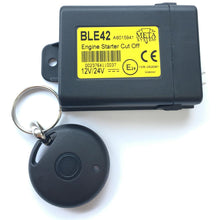Our prices shown include V.A.T. and installation in standard vehicles.
ICE Systems Immobilisers can defeat all of the following methods of attacks and prevent your vehicle from being stolen:
- Relay Theft (also known as Keyless Theft or Relay attack)*
- Physical Key Theft.
- Hacking / Key Cloning.
Operation:
Each time the vehicle ignition is switched off, the BLE42 immobiliser will arm. If the Bluetooth ID tag is not within range, the engine cannot be started.
The immobiliser will automatically disarm if the ID-Tag present when the ignition is switched ON.
The Meta BLE42 immobiliser comes with a simple 3-digit override PIN in case the tag is lost or the battery goes flat. There is also an LED installed within the vehicle which warns you when the battery in the tag is running low and also helps to deter would-be thieves.
Features:
- Comes with two key fobs which operate by proximity.
-
Bluetooth Low Energy ID-TAGS B9.5 (possibility to add up to 5 ID-TAGS).
- Status LED.
- Override code button: Emergency release through override code.
- No subscription costs.
*Immobilisers for modern vehicles in depth:
Despite the fact that all new cars sold in Europe and elsewhere come with an immobiliser system as standard, thieves have taken advantage of technology and can now steal modern cars quicker than cars from the 80s and 90s.
There are many ways thieves can steal cars some using technology but also conventional methods such as stealing keys.
Relay Theft (also known as Keyless Theft or Relay attack)
Criminals use this method to steal cars with a keyless entry and keyless ignition. They use a relay transmitter and a separate relay receiver to bridge the distance between the key and the car.
One criminal then stands by the car with his transmitter, while a second waves his receiver around the perimeter of the house. If the vehicle key is close enough the receiver will detect its signal, amplify it and send it to the accomplice’s transmitter.
Hacking.
This method is a little more difficult as it generally requires breaking into the vehicle to obtain access to the vehicles diagnostic OBD port. Using a programming devices thieves connect to your car with a computer and programme a new key, then steal the vehicle.
Key Theft
This method requires the thief to physically obtain the keys. Methods used include fishing keys through letter boxes of houses, pick pocketing or breaking into property.




